Aging-Friendly Design Research: Knowledge Graph Construction for Elderly Advantage Applications
Abstract
1. Introduction
2. Theoretical Overview
2.1. Aging-Friendly Design
2.2. Strengths Perspective Theory
2.3. Knowledge Graph
3. Presentation of the “Elderly Advantages Knowledge Graph” Program
3.1. Challenges of Integrating Elderly Advantages into Design: A Pain Point Analysis
3.1.1. Exploratory Experiments: Designing with Elderly Advantages
3.1.2. Pain Points Analysis and Need Extraction
3.2. Proposal of Solutions
3.2.1. Introduction of Strengths Perspective Theory
3.2.2. Conceptualization of “Elderly Advantages Knowledge Graph”
3.3. Functional Envisioning of Elderly Advantages Knowledge Graphs
3.3.1. Advantageous Features Search
3.3.2. Search for Advantages Related to Needs
3.3.3. Prioritization of Advantages
4. “Elderly Advantages Knowledge Graph” Construction
4.1. Elderly Advantages and Design Application Case Studies
4.1.1. Methods Used in Case Study Research
- KJ Method (Affinity Diagram)
- AHP (Analytic Hierarchy Process)
4.1.2. Data Survey
- User Behavior Survey
- User Needs Survey
- Elderly Advantages Survey
- Summary of research data
4.1.3. Demand Data Processing
- Categorization of needs
- Analytic Hierarchy Process and Attribute Definition of Needs
- Data collation
4.1.4. Advantage Data Processing
- Classification of advantages
- Establishing relevance to needs
- Data collation
4.2. Ontology Construction for Elderly Advantages Knowledge Graph
4.2.1. Core Classes and Their Attribute Relationship Definitions
4.2.2. Data Mapping Rules
4.3. Extraction of Knowledge
4.4. Knowledge Graph Functionality Evaluation
4.4.1. Functional Task Testing
- “Advantage Feature Retrieval” Test Process
- “Relevant Advantage Retrieval for Needs” Test Process
- “Priority Judgment for Advantage Application” Test Process
4.4.2. Survey on Satisfaction with the Testing Process
5. Discussion
5.1. Theoretical Contributions and Practical Implications
5.2. Current Issues and Future Prospects
5.3. Supplementary Explanation of the Method’s Applicability
6. Conclusions
Author Contributions
Funding
Institutional Review Board Statement
Informed Consent Statement
Data Availability Statement
Conflicts of Interest
References
- Available online: https://www.who.int/zh/news-room/fact-sheets/detail/ageing-and-health (accessed on 1 October 2024).
- Cozza, M.; Tonolli, L.; D’Andrea, V. Subversive Participatory Design: Reflections on a Case Study. In Proceedings of the 14th Participatory Design Conference: Short Papers, Interactive Exhibitions, Workshops-Volume 2 (PDC ’16), Aarhus, Denmark, 15–19 August 2016; ACM: New York, NY, USA, 2016; pp. 53–56. [Google Scholar]
- Mei, Z.P. Research on Aging Issues—A Collection of Materials from the World Assembly on Aging; China Translation and Publishing Corporation: Beijing, China, 1983. [Google Scholar]
- Zhao, C. Building the Theoretical Model for Aging Design: Intuitive Cognition, Prior Knowledge and Familiarity in the Context of Technology and Culture. Art Des. 2022, 5, 12–19. [Google Scholar] [CrossRef]
- Gu, M.M. The Research on Social Work Intervention in Cultivation the Elderly Volunteers with Strengths Perspective–Taking the X Community Y Project in Foshan city as an Example; South China University of Technology: Guangzhou, China, 2018. [Google Scholar]
- Lin, L. Intelligence Enhancement Design: A New Form of Design for the Aged from the Perspective of Advantage. Art Des. 2022, 5, 31–39. [Google Scholar] [CrossRef]
- Duque, E.; Fonseca, G.; Vieira, H.; Gontijo, G.; Ishitani, L. A systematic literature review on user centered design and participatory design with older people. In Proceedings of the 18th Brazilian Symposium on Human Factors in Computing Systems, Vitória, Brazil, 22–25 October 2019; pp. 1–11. [Google Scholar]
- Peng, Y.N.; Zhou, S.H. Analysis on the Governance Mechanism of the Multigenerational Housing Communities from the Perspective of Actor Network: A Case Study of Ledo Multigenerational Housing in Cologne, Germany. Urban Plan. Int. 2018, 33, 75–81. [Google Scholar]
- Li, Y.; Liu, G.C.; Liu, S.; Niu, R.C.; Ren, T.G. Ergonomic Design of Shared Elderly Mobility Scooter Based on AHP-QFD. Packag. Eng. 2023, 44, 52–60. [Google Scholar]
- Luo, J.; Zhao, X. Design of Age-friendly Home Nursing Beds Based on AHP-AD-TOPSIS Model. Packag. Eng. 2024, 45, 111–120. [Google Scholar]
- Ma, M.Y.; Song, W.; Qi, Y.C.; Han, Y.; Nian, X.C. Functional Food Packaging Design for the Elderly Based on Analytic Hierarchy Process. Packag. Eng. 2024, 45, 317–324. [Google Scholar]
- Xu, Z.X.; Yi, X.W.; Bao, J.; Li, T.R.; Zhang, J.B.; Zheng, Y. Construction and Application of Knowledge Graph for Epidemiological Investigation. Comput. Appl. 2025, 1–12. Available online: http://kns.cnki.net/kcms/detail/51.1307.TP.20241008.1636.004.html (accessed on 3 March 2025).
- Mo, Z.; Gong, L.; Gao, J.; Cui, H.; Lan, J. A Knowledge Graph-Based Implicit Requirement Mining Method in Personalized Product Development. Appl. Sci. 2024, 14, 7550. [Google Scholar] [CrossRef]
- Greif, L.; Hauck, S.; Kimmig, A.; Ovtcharova, J. A Knowledge Graph Framework to Support Life Cycle Assessment for Sustainable Decision-Making. Appl. Sci. 2025, 15, 175. [Google Scholar] [CrossRef]
- Cheng, Y.H.; Li, P.P. Research on Design of Bedroom Furniture Suitable for the Aged. Furnit. Inter. Des. 2019, 8, 80–82. [Google Scholar]
- Shi, Y.; Wu, H.P.; Zhang, Z.Y.; Liang, G.W.; Zhao, J. Research on Aging friendly Design of Different Elderly Care Models under Human Factors Engineering. Chin. J. Gerontol. 2016, 36, 987–991. [Google Scholar]
- Saleebey, D. Strengths Perspective in Social Work Practice; East China University of Science and Technology Press: Shanghai, China, 2015. [Google Scholar]
- Meng, J. Exploration of the Theoretical Connotation of the Advantage Perspective in Social Work. J. East China Univ. Sci. Technol. Soc. Sci. Ed. 2019, 34, 55–64. [Google Scholar]
- Strengths-Based Approach in Social Work: 6 Examples & Tools. Available online: https://positivepsychology.com/social-work-strength-based-approach/ (accessed on 31 May 2022).
- Liu, Y.C.; Liu, J.; Xi, S.L.; Zhao, X.R.; Hou, N.; Zhu, W.L. Research on the Digital Knowledge Graph of Central Axis Art Value Based on Neo4j. Packag. Eng. 2024, 45, 211–223. [Google Scholar]
- Zhang, X.F.; Zhang, L.P.; Yan, S.; Hou, M.; Zhao, Y.B. Personalized learning recommendation in collaboration with knowledge graph and large language model. Comput. Appl. 2025, 1–15. Available online: http://kns.cnki.net/kcms/detail/51.1307.tp.20241012.1733.014.html (accessed on 3 March 2025).
- Jiang, M.J.; Zhang, W.C.; Rong, H.M.; Zhang, J.Q.; Huang, S.H. Helicopter component assembly sequence planning method based on knowledge graph. J. Graph. Sci. 2024, 45, 1062–1070. [Google Scholar]
- Fogg, B.J. Tiny Habits; Tianjin Science and Technology Press: Tianjin, China, 2021. [Google Scholar]
- Liu, J.; Sun, X.; Zhang, Y.Q. Educational resource content review method based on knowledge graph and large language model collaboration. J. East China Norm. Univ. Nat. Sci. Ed. 2024, 5, 57–69. [Google Scholar]
- Huang, J.Z.; Ma, Y.X.; Hu, G.Y. Research progress on elderly travel behavior from a health perspective. Sci. Technol. Rev. 2020, 38, 69–75. [Google Scholar]
- Ma, X.H.; Liu, W.L. Design of a “One-stop” Fruit APP Based on the KJ-KANO Model. Packag. Eng. 2024, 45, 192–203. [Google Scholar]
- Liu, W.L.; Ma, X.H. Research on Parent-Child Home Cultural and Creative Product Design Based on KJ-KANO Model. Furnit. Inter. Des. 2024, 31, 72–77. [Google Scholar]
- Xu, X.Q.; Cheng, Y.S.; Chen, G.Q. Evaluation Method and Application of RV Modeling Based on AHP Method. J. Mach. Des. 2020, 37, 140–144. [Google Scholar]
- Xie, W.T.; Xu, C. Design of Intelligent Kitchen Appliances for the Elderly Based on KJ-AHP-VIKOR Integration Method. Packag. Eng. 2024, 45, 411–419. [Google Scholar]
- Li, X.Y.; Yang, X.Y. Shopping Cart Design for the Visually Impaired Based on Behavior-significance Mapping. Mach. Des. Res. 2022, 38, 172–178. [Google Scholar]
- Graybeal, C. Strengths-based social work assessment: Transforming the dominant paradigm. Fam. Soc. 2001, 82, 233–242. [Google Scholar] [CrossRef]
- Xie, Q.S.; Lu, D.B. Social Emotion Action Expression Method of Robots Based on Customer Journey Map. Packag. Eng. 2023, 44, 84–90. [Google Scholar]
- Wang, B.; Huang, T.; Zhou, L.; Guan, L.; Wan, K. Integration of EMU Overall Design Model Based on Ontology–Knowledge Collaboration. Appl. Sci. 2024, 14, 7828. [Google Scholar] [CrossRef]
- Zhang, J.X.; Wang, Y.Q.; Jiao, X.M.; Zhang, Y.X. An ontology and NLP-based knowledge graph construction method for dangers of earth-rock dams. J. Hydraul. Eng. 2024, 55, 9. [Google Scholar] [CrossRef]
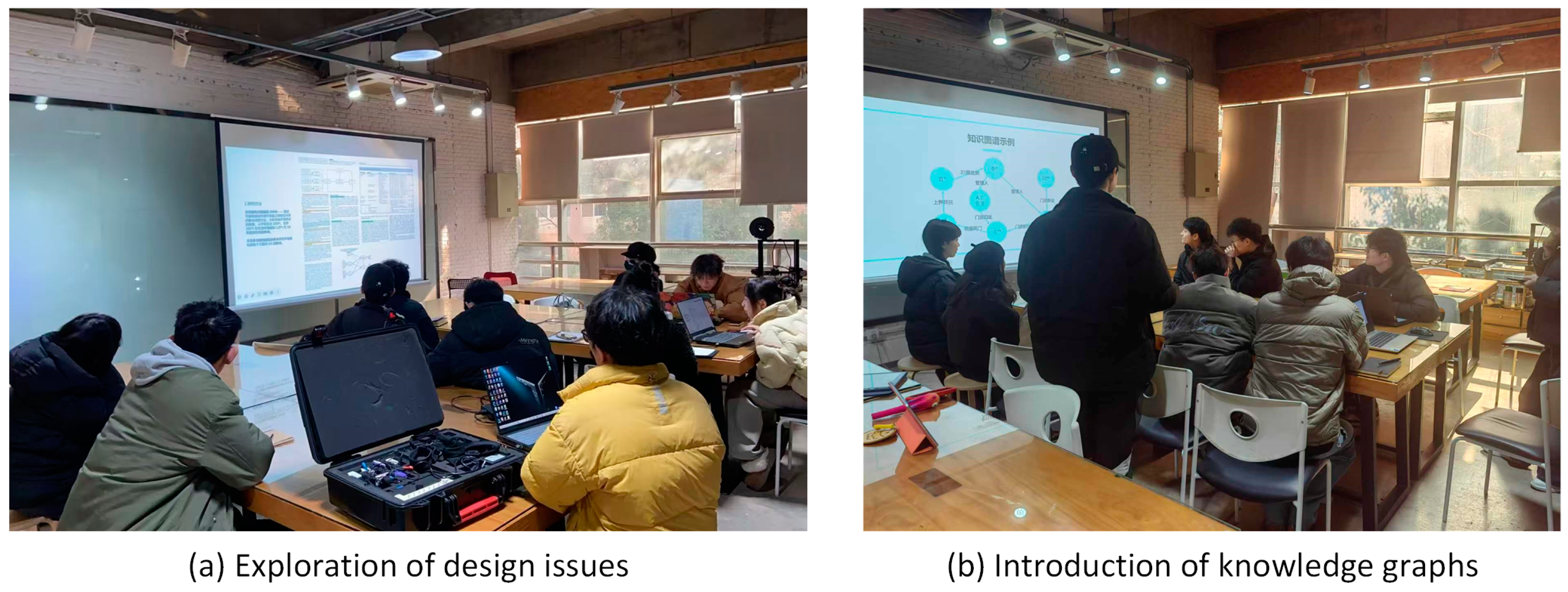
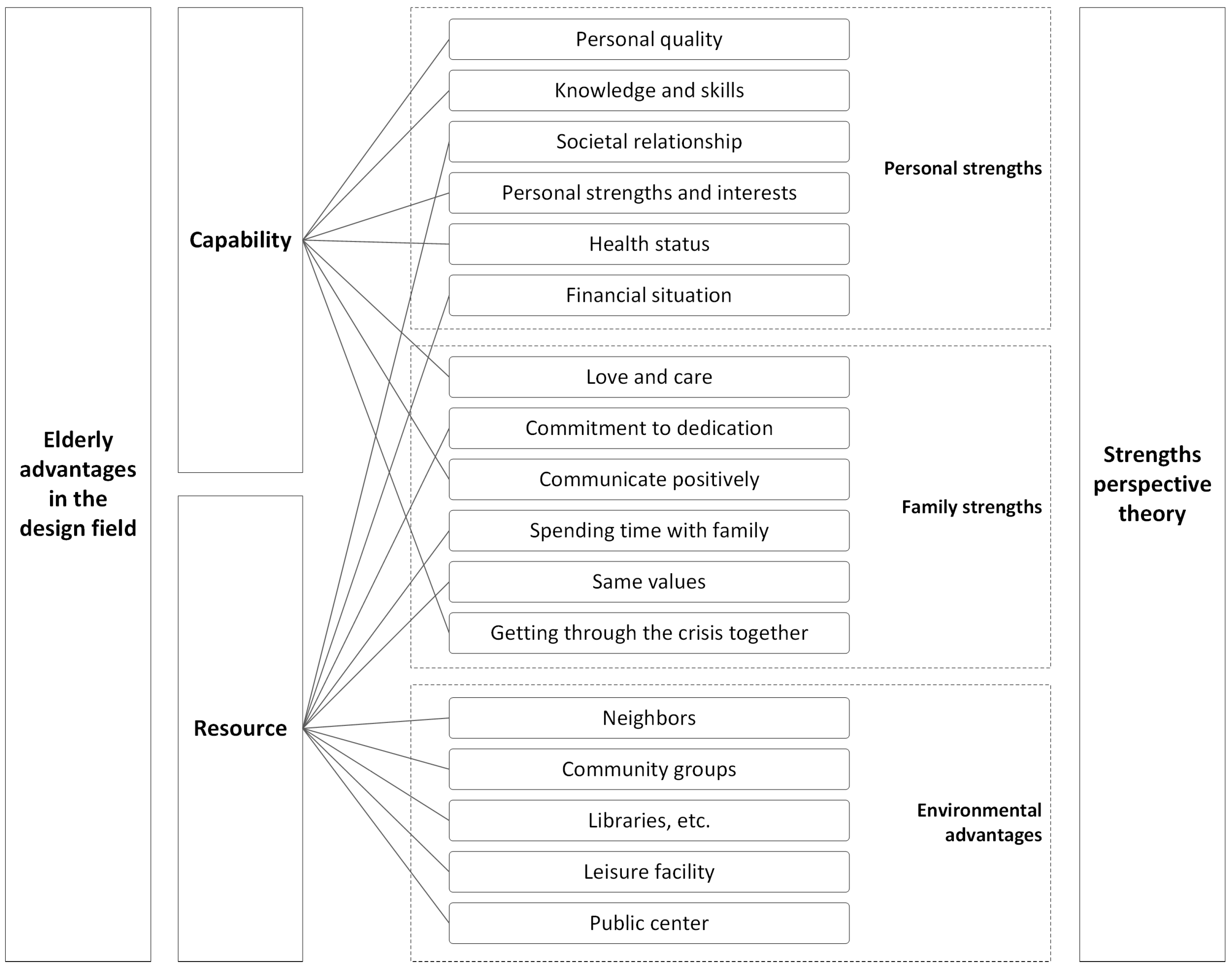
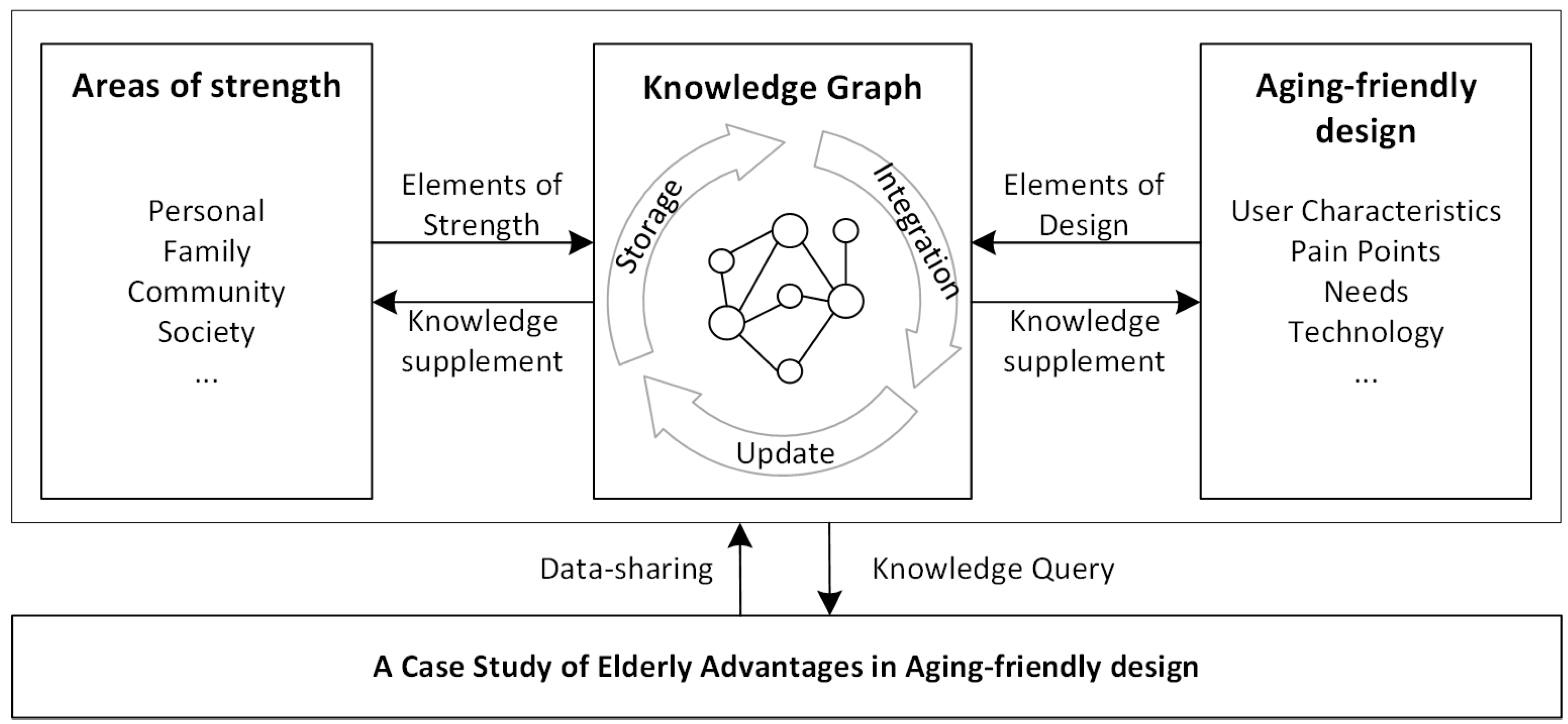
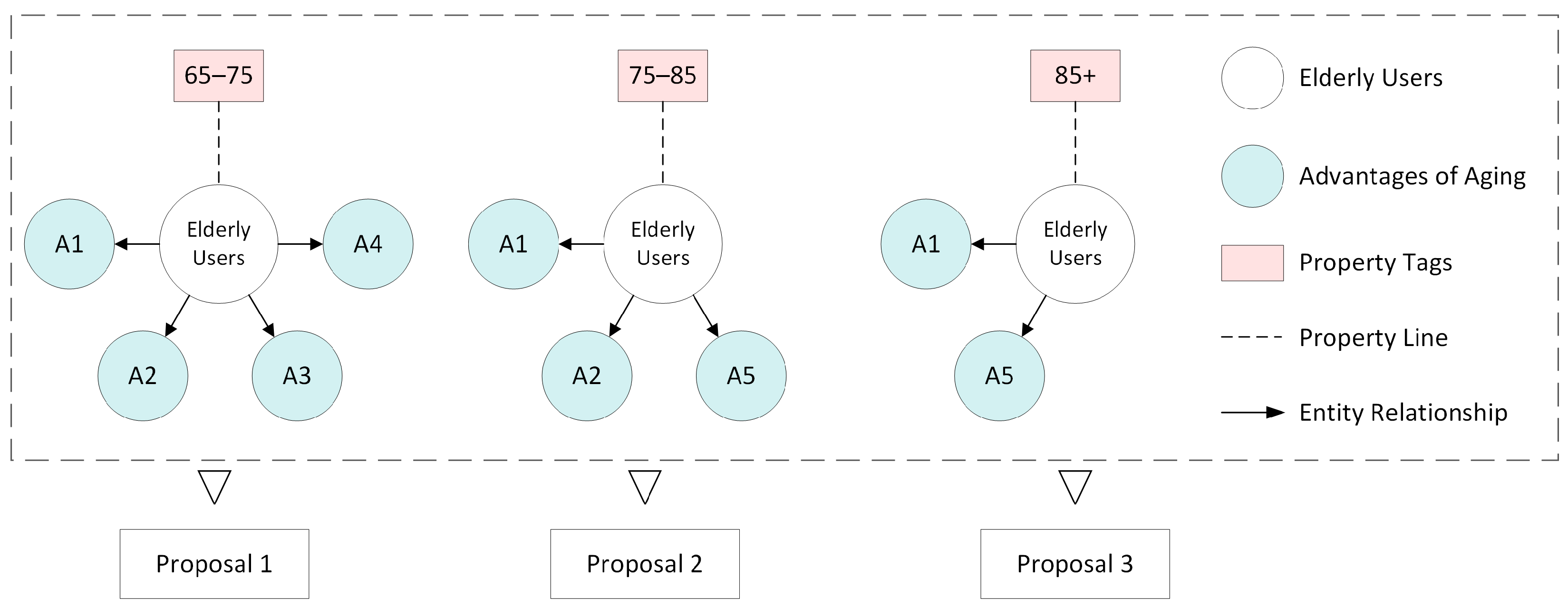
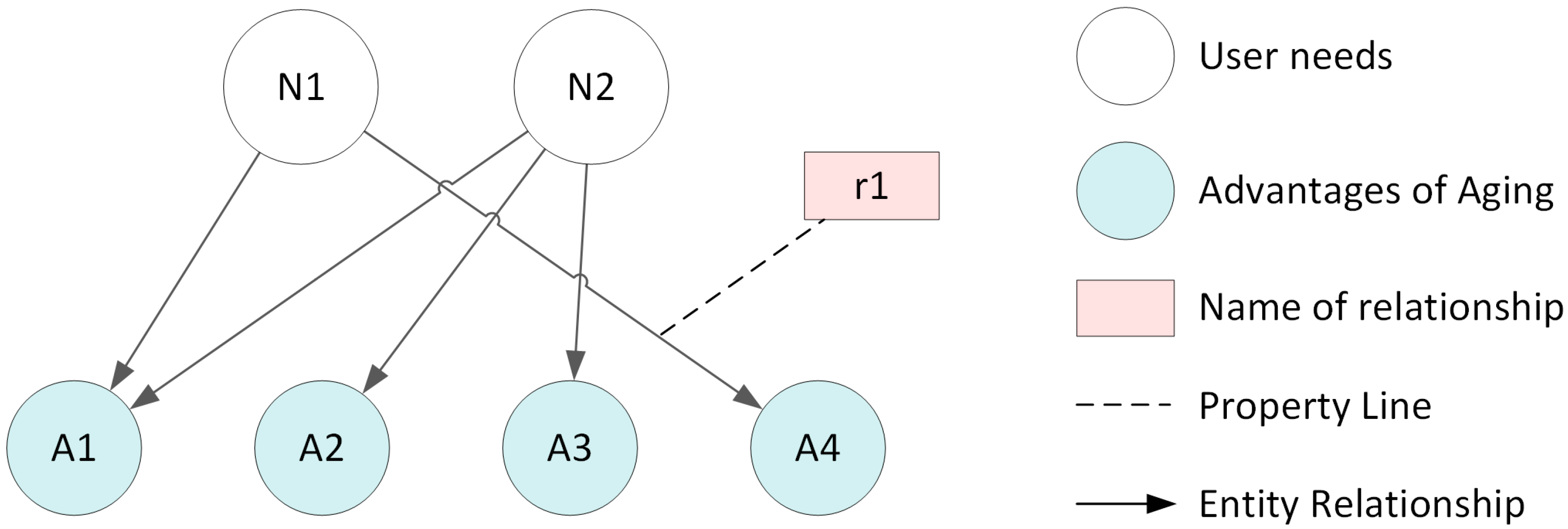

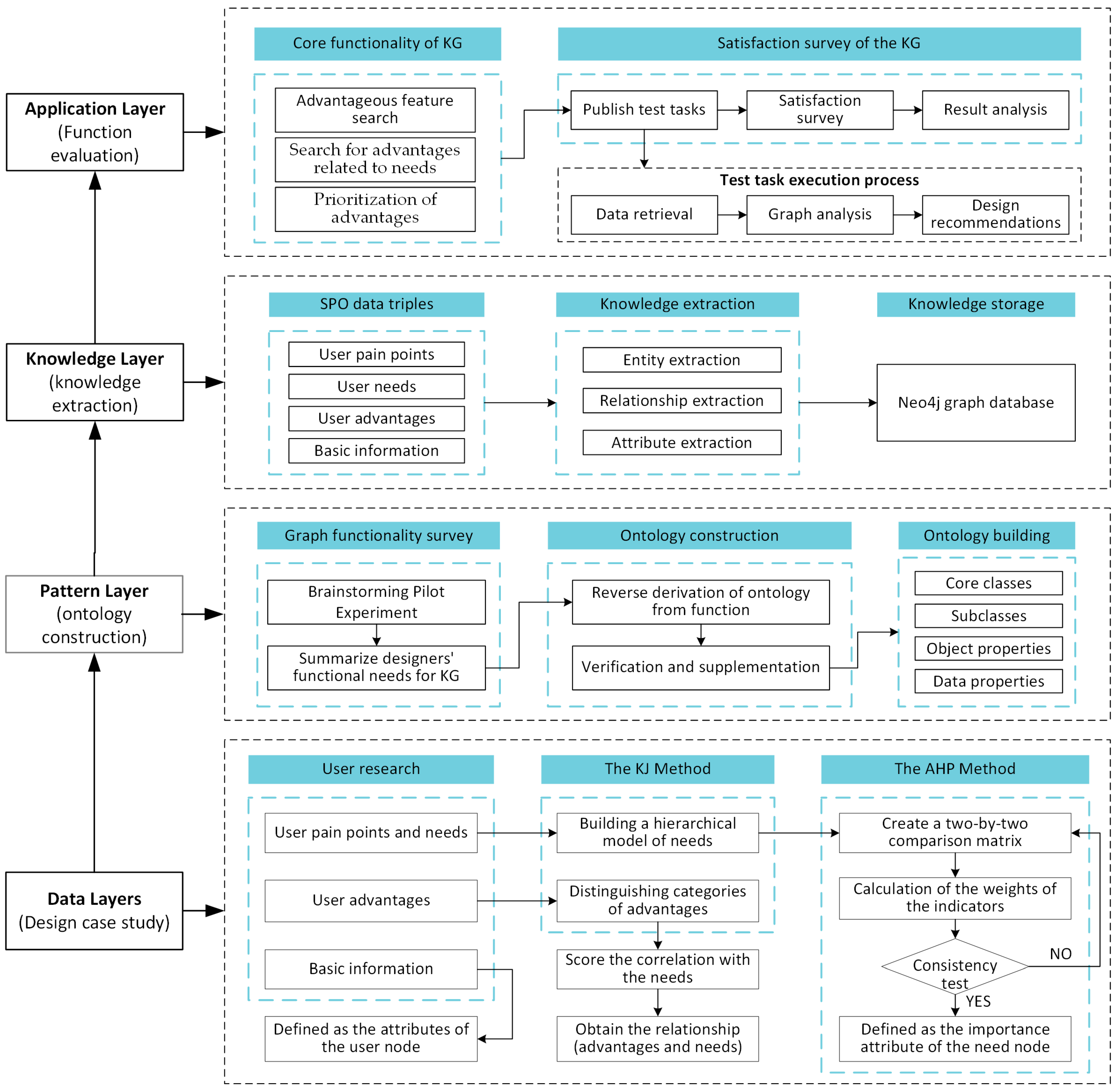

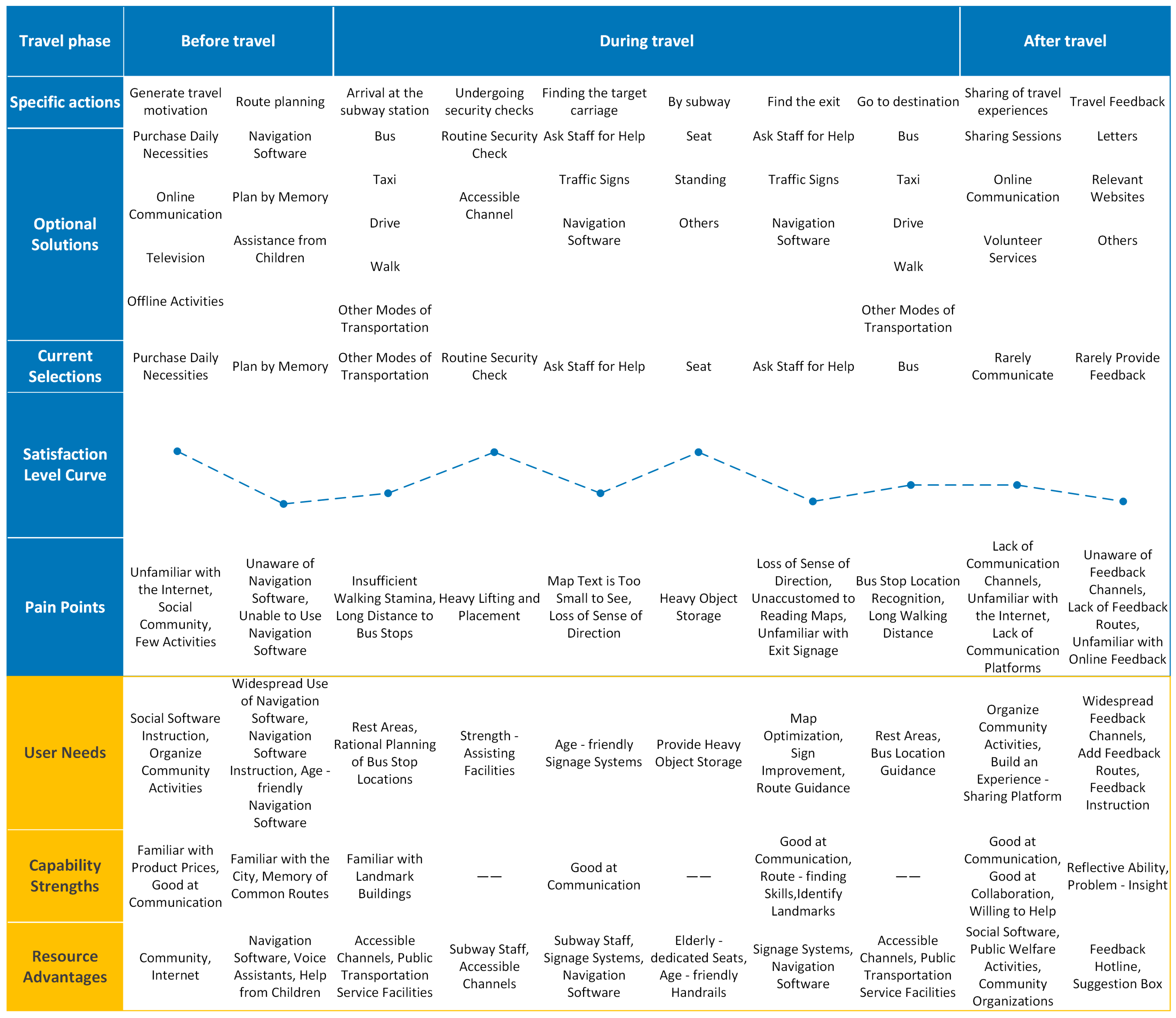
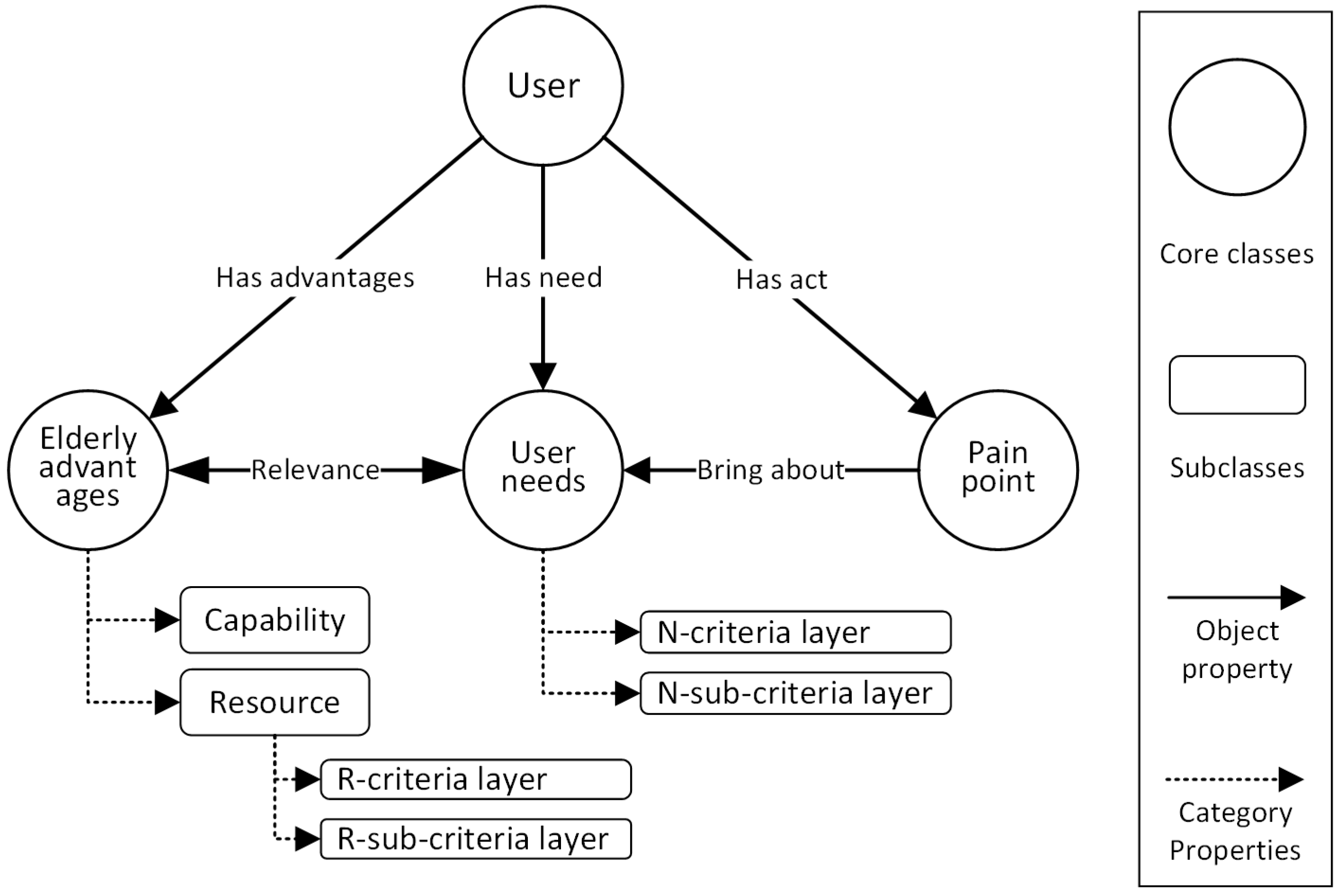
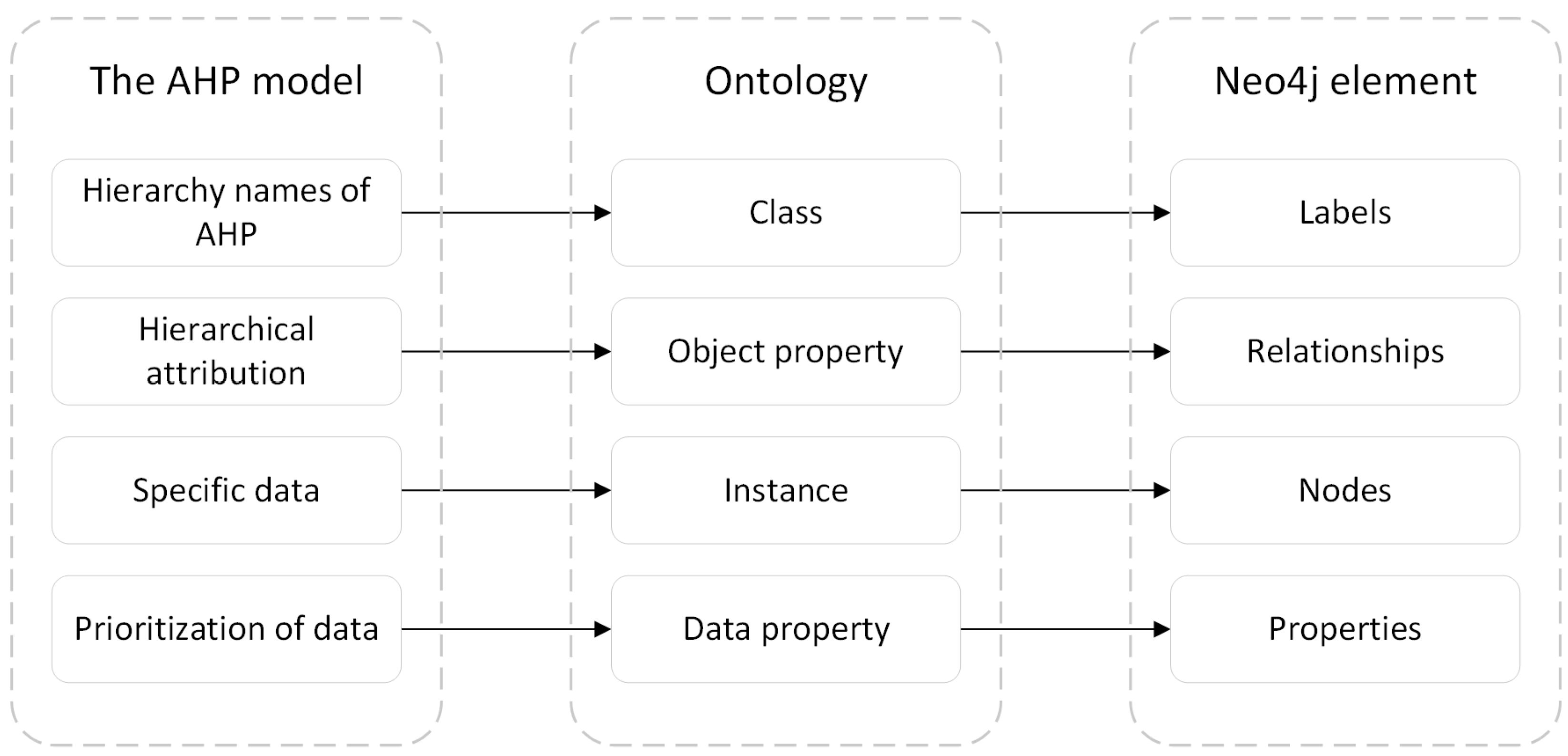

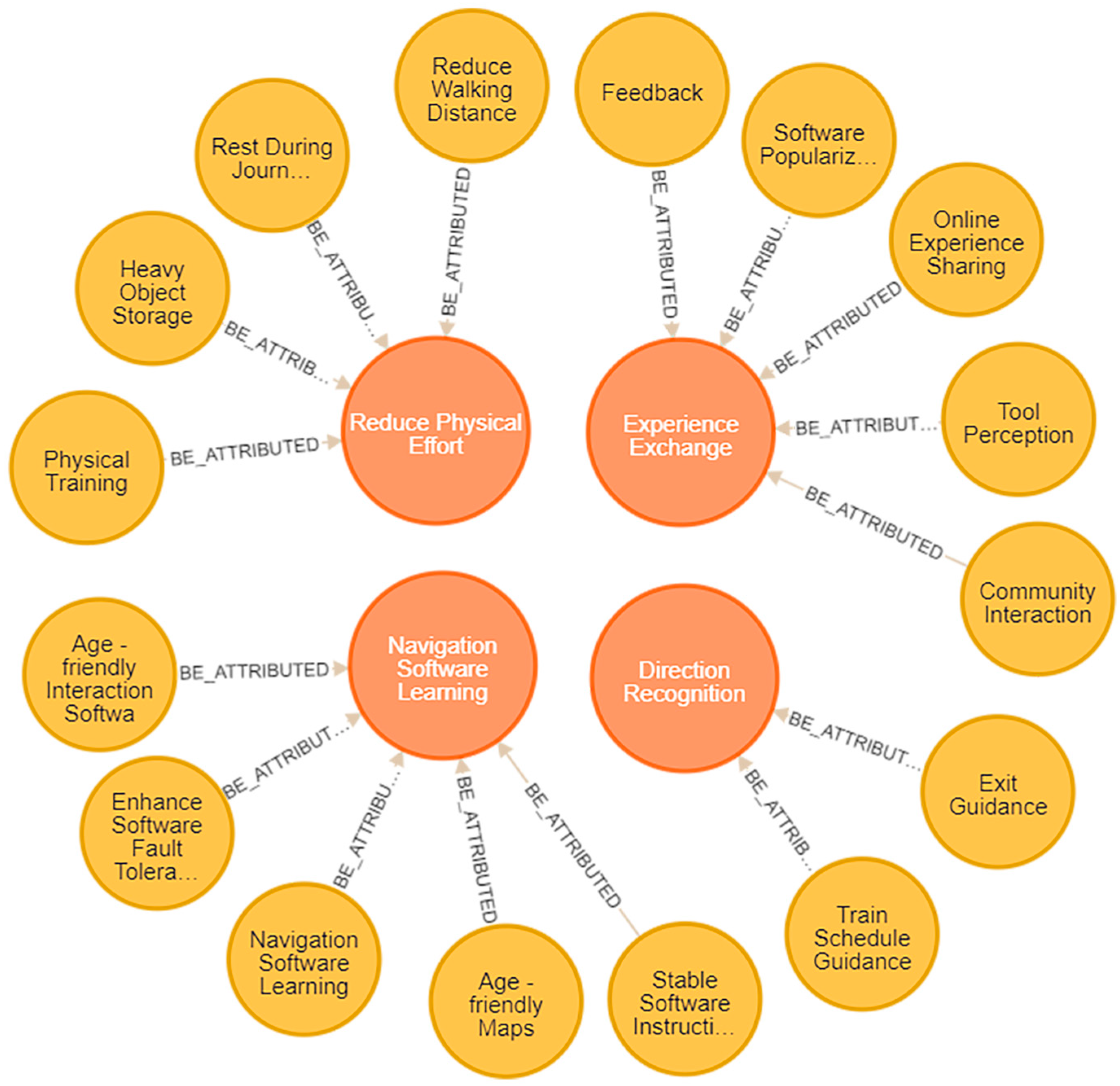
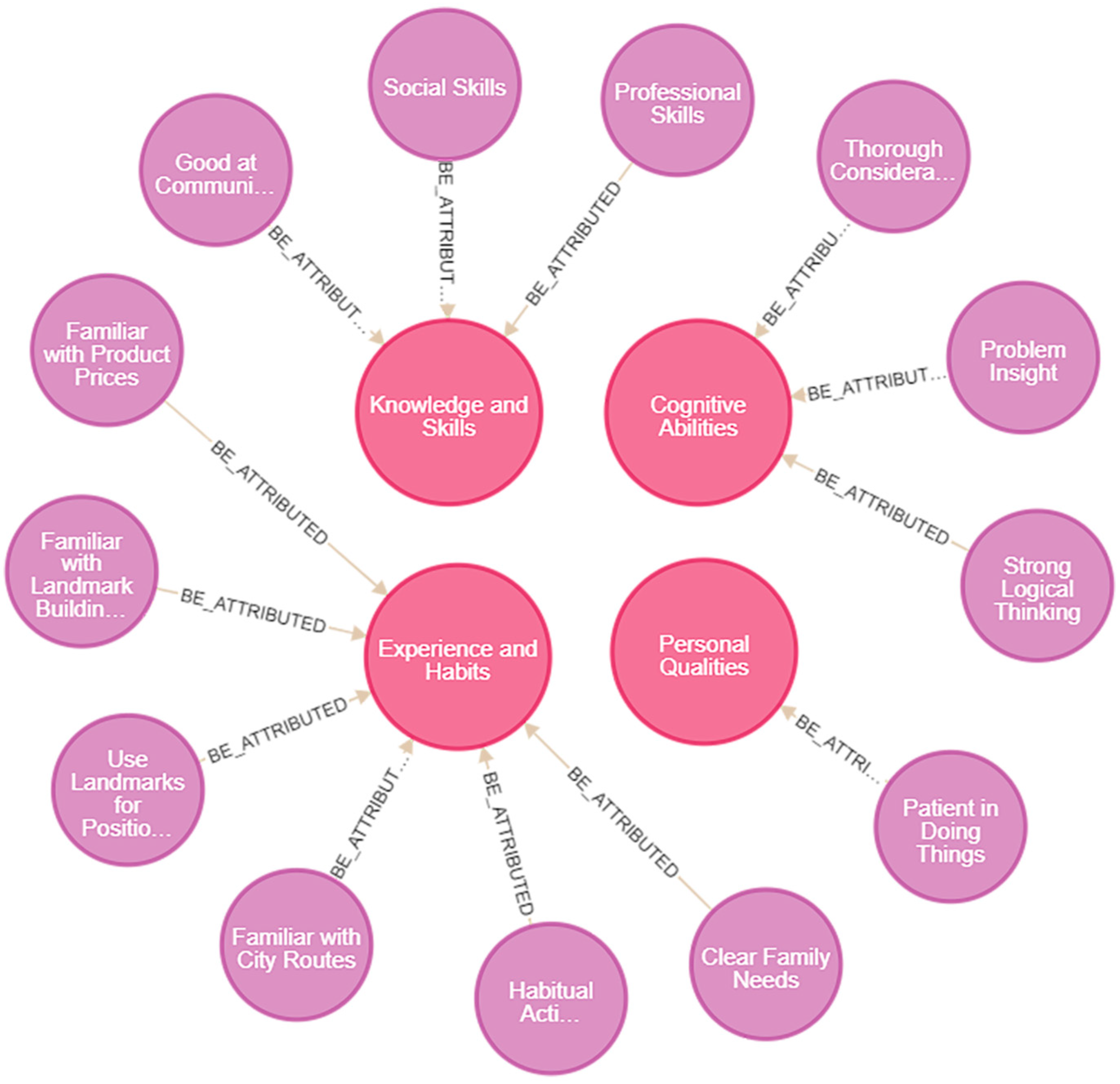
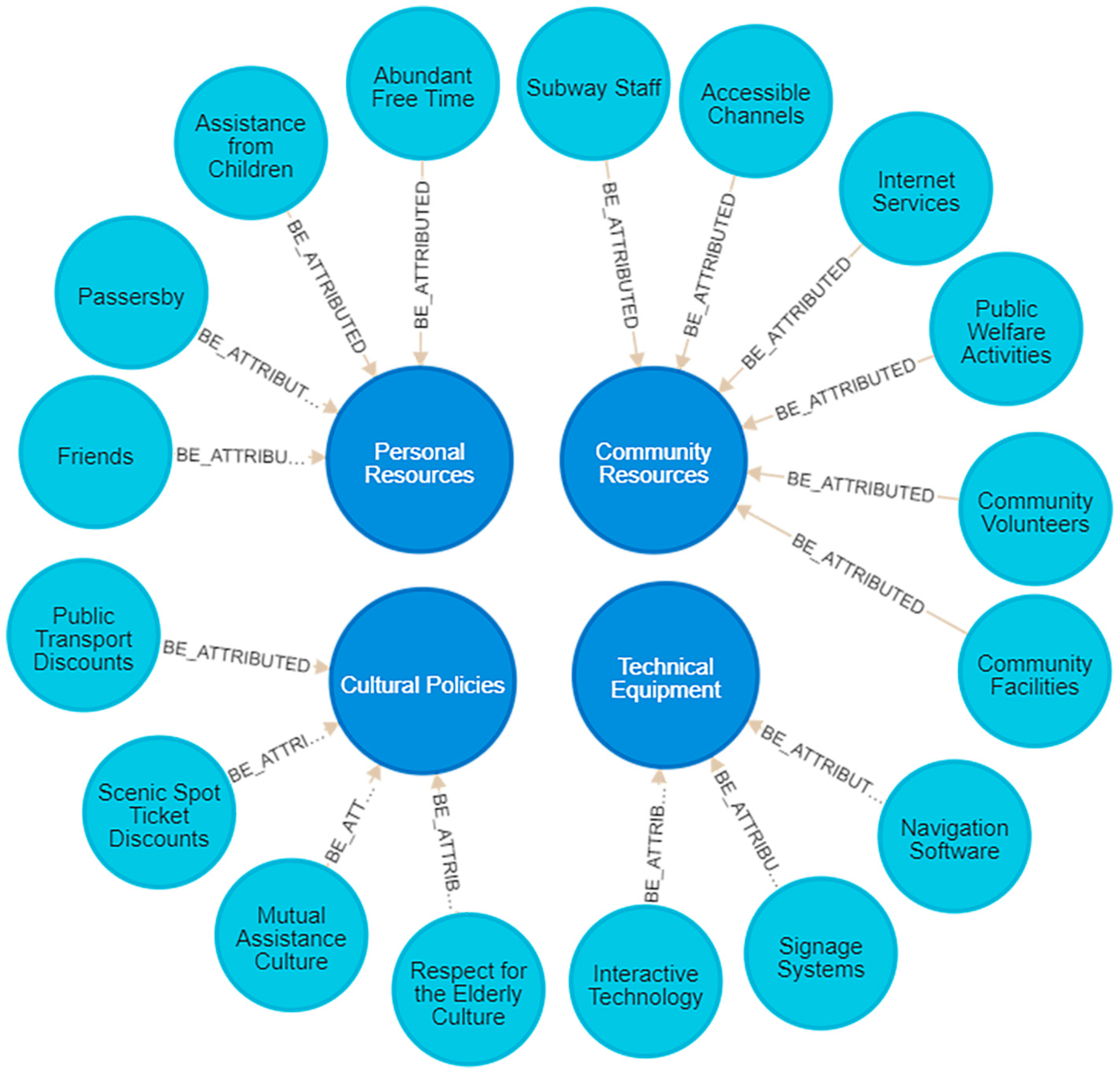



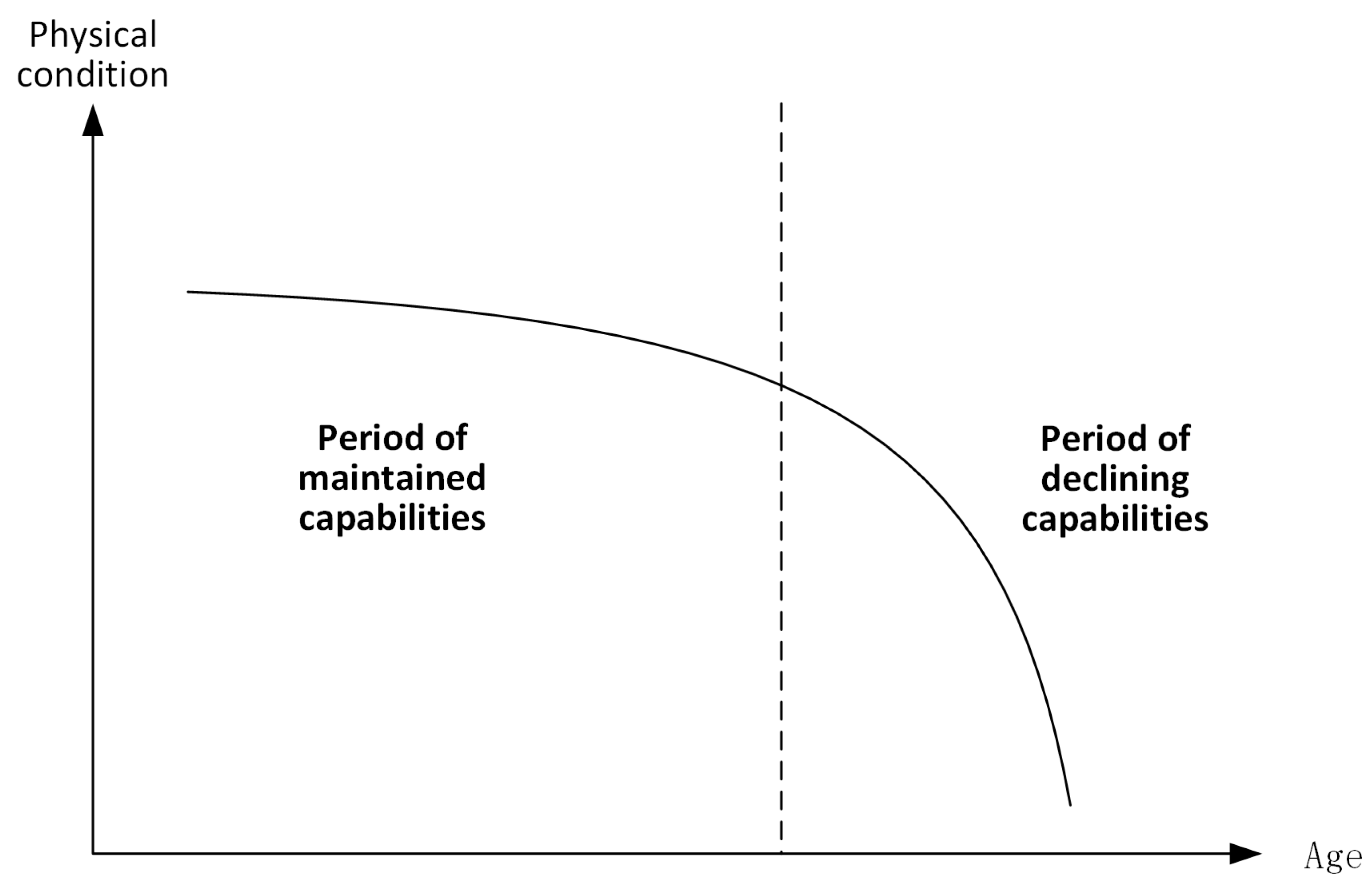
| Serial No. | Question |
|---|---|
| 1 | Are there difficulties in applying elderly advantages in design? |
| 2 | What difficulties exist? Please list at least one. |
| 3 | What do you think is the key to solving these problems? |
| Original Representative Statements | Pain Points in Advantage Design | No. of Questionnaires | Designers’ Needs |
|---|---|---|---|
| Focusing on elderly advantages is indeed important, but the design field currently lacks a methodology for mining elderly advantages. | (a1) Lack of advantage-related data-mining methods | 7 | (A) Introduce advantageous research methods |
| I think the content of elderly advantages is too vague, such as experience advantage, decision-making advantage, what specific contents are included, and what the specific aspects are. | (a2) The specifics of elderly advantages are vague | 8 | (B) Clarify the categorization and hierarchy of advantages |
| We usually use interview methods, observation methods, and other manual collection methods in design research. Elderly advantage data collection is inefficient. On the one hand, it is not possible to collect a sufficient amount of data, and on the other hand, some of the advantages cannot be useful for design activities. | (a3) Inefficient data collection | 23 | (C) Promote the sharing of advantageous data |
| (a4) Insufficient superior samples available in single studies | |||
| There is less research on elderly advantages in the field of design, and there are difficulties in finding information about previous research. | (a5) Difficulty in obtaining information on existing studies | 13 | (C) Promote the sharing of advantageous data |
| The relationship between the data on elderly advantages obtained through the research and the design elements is not clear, and it is not possible to determine the needs corresponding to specific advantage phrases. | (a6) Ambiguous relationship between advantages and design elements | 15 | (D) Clarify the relationship between advantages and design elements |
| When faced with multiple advantages corresponding to the same need, it is difficult to prioritize the use of advantage phrases. | (a7) Unclear prioritization of advantageous applications | 8 | (E) Define the relevance of advantages to design elements |
| Genders | Number | Age Range | Number | Mobility of the Elderly | Number |
|---|---|---|---|---|---|
| Male | 29 | 65–73 | 51 | Independent | 59 |
| Female | 43 | 74–85 | 21 | Instrumental | 13 |
| ROPES | Contents of the Assessment | Example Problem (Using Route Planning as An Example) |
|---|---|---|
| Resources | Individuals and families | What are some methods of route planning? |
| Community involvement | What kinds of people are available to help? | |
| Social context | What tools are available? | |
| Opportunities | Present focus | How do you do route planning in your life? |
| Emphasis on choice | What methods have not been tried? | |
| Possibilities | Future focus | How would you like to carry out route planning in the future? |
| Creativity | How can these goals be realized? |
| Sub-Criteria Layer | Criteria Layer | Objective Layer |
|---|---|---|
| C1—Heavy-Load Storage | B1—Reduced Physical Exertion | Transfoem the environment to assist elderly mobility |
| C2—Rest on the Way | ||
| C3—Reduced Walking | ||
| C4—Physical Training | ||
| C5—Aging-Friendly Software Interaction | B2—Software Learning | |
| C6—Software Teaching | ||
| C7—Software Fault Tolerance | ||
| C8—Aging-Friendly Map | B3—Direction Recognition | |
| C9—Metro Trip Alert | ||
| C10—Metro Exit Alerts | ||
| C11—Related Software Popularization | ||
| C12—Cognitive Tools and Resources | ||
| C13—Building a Networking Platform | B4—Communication Feedback | |
| C14—Experience Sharing in the Community | ||
| C15—Feedback on Traveling |
| Sub-Criteria Layer | Criteria Layer | Objective Layer | Sub-Criteria Layer | Criteria Layer | Objective Layer |
|---|---|---|---|---|---|
| Good at Communication | Knowledge and Skills | Capability Advantage Classification | Friends | Personal Resources | Resource Advantage Classification |
| Professional Skills | Passersby | ||||
| Social Skills | Assistance from Children | ||||
| Strong Logical Thinking | Cognitive Abilities | Abundant Free Time | |||
| Problem Insight | Community Facilities | Community Resources | |||
| Thorough Consideration | Public Welfare Activities | ||||
| Familiar with Landmark | Experience and Habits | Community Volunteers | |||
| Use Landmarks for Positioning | Accessible Channels | ||||
| Habitual Joint Actions | Subway Staff | ||||
| Clear Family Needs | Internet Services | Technical Equipment | |||
| Familiar with Product Prices | Interactive Technology | ||||
| Familiar with City Routes | Navigation Software | ||||
| Patient in Doing Things | Personal Qualities | Signage Systems | |||
| Mutual Assistance Culture | Cultural Policies | ||||
| Respect for the Elderly Culture | |||||
| Public Transport Discounts | |||||
| Scenic Spot Ticket Discounts |
| Good at Communication | Skills Specialization | Insight into the Problem | Habits in Action Together | Familiarization with Landmarks | Familiarity with City Routes | Socially Adept | Help for Children | Network Service | Voice Interaction Technology | Navigation Simulation Software | Community Volunteers | Metro Staff | |
|---|---|---|---|---|---|---|---|---|---|---|---|---|---|
| Software Teaching | 3 | 0 | 0 | 0 | 0 | 0 | 0 | 2 | 2 | 0 | 3 | 3 | 0 |
| Software Popularization | 3 | 0 | 0 | 0 | 0 | 0 | 0 | 2 | 2 | 0 | 0 | 2 | 1 |
| Aging-Friendly Interaction | 2 | 0 | 2 | 0 | 2 | 2 | 0 | 0 | 0 | 3 | 3 | 0 | 1 |
| Community Activities | 3 | 1 | 0 | 3 | 1 | 1 | 0 | 0 | 0 | 0 | 0 | 3 | 0 |
| Metro Trip Alert | 0 | 0 | 0 | 0 | 3 | 1 | 2 | 0 | 2 | 0 | 3 | 0 | 2 |
| Cognitive Tools and Resources | 3 | 0 | 0 | 0 | 0 | 0 | 0 | 2 | 2 | 0 | 2 | 2 | 3 |
| Reduced walking | 0 | 0 | 0 | 0 | 0 | 3 | 0 | 0 | 0 | 0 | 3 | 0 | 0 |
| Serial No. | Test Task Name |
|---|---|
| 1 | Open the Neo4j graph database using the task interface and browser. |
| 2 | Execute three query tasks using Cypher commands. |
| 3 | Conduct discussions and analysis based on the feedback from the graph. |
| 4 | Propose design suggestions based on the content of the graph. |
| Serial No. | Question | Purpose | Satisfaction Mean |
|---|---|---|---|
| 1 | Is the operation process clear? | Process satisfaction | 3.9 |
| 2 | Is it easy to understand and master? | Usability and learnability | 2.8 |
| 3 | Is the feedback content accurate? | Data structure satisfaction | 4.0 |
| 4 | Are the relationships among the contents clear? | Relationship mining satisfaction | 4.5 |
| 5 | Does it enhance design creativity? | Creativity enhancement satisfaction | 3.8 |
| 6 | Does it help guide the design thinking? | Improvement of thought process satisfaction | 4.6 |
| 7 | Has the graph fulfilled its intended function? | Satisfaction with graph functionality | 4.2 |
| Criteria Layer | Weight Value | Sub-Criteria Layer | Weight Value | Comprehensive Weight Value | Rankings |
|---|---|---|---|---|---|
| B1—Reduced Physical Exertion | 0.0811 | C1—Heavy-Load Storage | 0.1069 | 0.0087 | 14 |
| C2—Rest on the Way | 0.2923 | 0.0237 | 11 | ||
| C3—Reduced Walking | 0.5435 | 0.0441 | 7 | ||
| C4—Physical Training | 0.0574 | 0.0047 | 15 | ||
| B2—Software Learning | 0.4864 | C5—Aging-Friendly Software Interaction | 0.2308 | 0.1123 | 3 |
| C6—Software Teaching | 0.6923 | 0.3367 | 1 | ||
| C7—Software Fault Tolerance | 0.0769 | 0.0374 | 8 | ||
| B3—Direction Recognition | 0.2932 | C8—Aging-Friendly Map | 0.0857 | 0.0251 | 10 |
| C9—Metro Trip Alert | 0.2536 | 0.0744 | 5 | ||
| C10—Metro Exit Alerts | 0.0440 | 0.0129 | 13 | ||
| C11—Related Software Popularization | 0.4508 | 0.1322 | 2 | ||
| C12—Cognitive Tools and Resources | 0.1660 | 0.0487 | 6 | ||
| B4—Communication Feedback | 0.1394 | C13—Building a Networking Platform | 0.1222 | 0.0170 | 12 |
| C14—Experience Sharing in the Community | 0.6480 | 0.0903 | 4 | ||
| C15—Feedback on Traveling | 0.2299 | 0.0320 | 9 |
Disclaimer/Publisher’s Note: The statements, opinions and data contained in all publications are solely those of the individual author(s) and contributor(s) and not of MDPI and/or the editor(s). MDPI and/or the editor(s) disclaim responsibility for any injury to people or property resulting from any ideas, methods, instructions or products referred to in the content. |
© 2025 by the authors. Licensee MDPI, Basel, Switzerland. This article is an open access article distributed under the terms and conditions of the Creative Commons Attribution (CC BY) license (https://creativecommons.org/licenses/by/4.0/).
Share and Cite
Li, X.; Wang, X.; Li, G. Aging-Friendly Design Research: Knowledge Graph Construction for Elderly Advantage Applications. Appl. Sci. 2025, 15, 2848. https://doi.org/10.3390/app15052848
Li X, Wang X, Li G. Aging-Friendly Design Research: Knowledge Graph Construction for Elderly Advantage Applications. Applied Sciences. 2025; 15(5):2848. https://doi.org/10.3390/app15052848
Chicago/Turabian StyleLi, Xiaoying, Xingda Wang, and Guangran Li. 2025. "Aging-Friendly Design Research: Knowledge Graph Construction for Elderly Advantage Applications" Applied Sciences 15, no. 5: 2848. https://doi.org/10.3390/app15052848
APA StyleLi, X., Wang, X., & Li, G. (2025). Aging-Friendly Design Research: Knowledge Graph Construction for Elderly Advantage Applications. Applied Sciences, 15(5), 2848. https://doi.org/10.3390/app15052848







